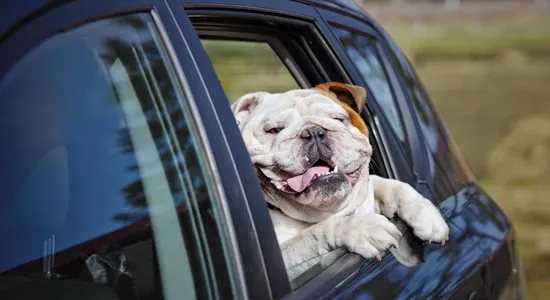Do Pets Have to Wear Seat Belts?

Is It Illegal for Fido to Ride in the Car Without His Seat Belt?
If you own a dog or a cat, chances are high that your furry friend rode as a passenger in your vehicle on at least a few occasions. You may have let them roam free in the backseat, permitted them to ride shotgun, or secured them in a crate, but are there laws in place that determine how pets are supposed to ride in the car?
We've gotten to the bottom of this puzzling issue. Read on to find out what kinds of laws exist that pertain to pet passengers.
Pets in the Car
Recent surveys have identified surprising patterns in the ways some owners transport their pets.

One survey sponsored by AAA and Kurgo Pet Products found that well over half of respondents had participated in at least one distracting behavior while driving with their dogs:
- 52% had pet their dog while driving
- 17% allowed their dog to sit in their lap while driving
- 13% gave food or treats to their dog while driving
- 4% acknowledged playing with their dog while driving
Seat Belt Laws
According to Pennsylvania's seat belt law, all drivers, all front seat passengers, and anyone under 18 years of age is required to wear a seat belt in a motor vehicle. PA's child seat belt laws have special provisions and guidelines for the proper use of safety and booster seats for children under eight.
Child restraint system laws are especially important because the airbags in most vehicles are engineered to protect standard, adult-sized people—not small children. While airbags provide lifesaving protection for adults in collisions, small children can actually be severely injured by the force of an airbag's deployment.
Similar to small children, pets also tend to fall short of the average height and weight of typical adults. Because of this, pets can be similarly at risk of injury by an airbag in an auto accident, yet when it comes to required pet restraint systems, very few states acknowledge unrestrained animals' danger to drivers, passengers, and themselves.

Car accident test simulations, done using a 12-pound canine crash test dummy, showed that at a speed of only 30 mph, an unrestrained dog will strike a barrier with 650 pounds of force on impact. On top of this, in the event of a car accident, unrestrained animals will most likely try to escape a vehicle if windows are broken and can then easily get lost or hit by other vehicles.
84% of the pet owners in the AAA survey stated that they have driven with their pets on a variety of non-essential car trips, yet only 16% used, or regularly use, any type of pet-restraint safety system.
Pet Restraint Driving Laws
In New Jersey, officers can stop a driver they believe is improperly transporting an animal. Tickets range from $250 - $1,000 per pet, and a driver can face a disorderly person's offense under animal-cruelty laws. In the past, state officers have cited drivers with dogs hanging their heads out of windows, drivers of pick-up trucks with unleashed dogs traveling in the truck bed, drivers with cats resting on their dashboards, and even one driver with a bird perched on their shoulder.
Hawaii openly prohibits drivers from having any unrestrained animal in their car. In the "Aloha" State, you can be fined $97 dollars for driving with a dog in your lap and $57 if the animal is unrestrained in a moving vehicle.
In Arizona, Connecticut, and Maine, distracted-driving laws can be used to charge drivers with pets on their laps.
Other states are on their way to enacting laws addressing the hazard that unrestrained pets pose in the car. However, just because no law of this nature exists in your state doesn't mean that your pet shouldn't be secured in your vehicle just like all of the other passengers.
The Best Ways to Secure Your Pet in the Car
There are plenty of options for pet-restraint systems to keep Fido safe in the car. Most of these options are relatively inexpensive and can be found at most pet stores.
Pet Safety Harnesses

A pet seat belt is made of adjustable straps that fit all varieties of dogs. Owners can purchase different types of seat belt harnesses that secure pets by attaching to, and working with, existing seat belts in cars. Remember, the safest place for a dog or cat to be secured is in the middle, back seat. Animals in the front seat have a far greater risk of being injured by the airbag in an accident.
Travel Crates

Travel crates and kennels were made for just that: traveling. Both hard- and soft-sided crates can be used in vehicles and work best for smaller cats and dogs. Your travel crate should always be properly secured inside the cabin by a seat belt or by some other measure. If it isn't, the crate could be projected forward if the driver brakes suddenly or is involved in a collision.
Both roadway safety and pet experts recommend that owners safely secure their pets if they choose to take them on car trips. Restraint systems not only help keep pets from distracting drivers, but also help protect animals and other passengers if a car accident were to occur.
Sources: “Buckle Up That Dog! Do Your Part to Prevent Car Wrecks.” Gopetfriendly.com. October 7, 2015.
“Pet Passenger Safety.” Exchange.aaa.com. October 7, 2015.
.svg)






.webp)